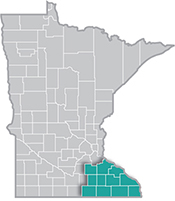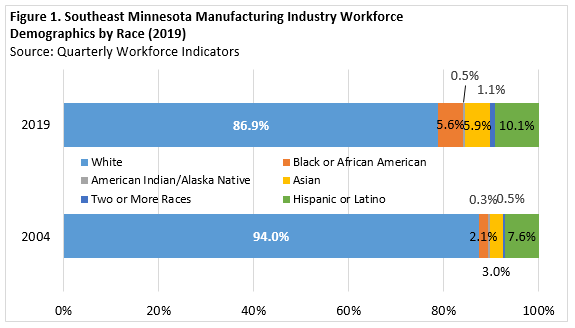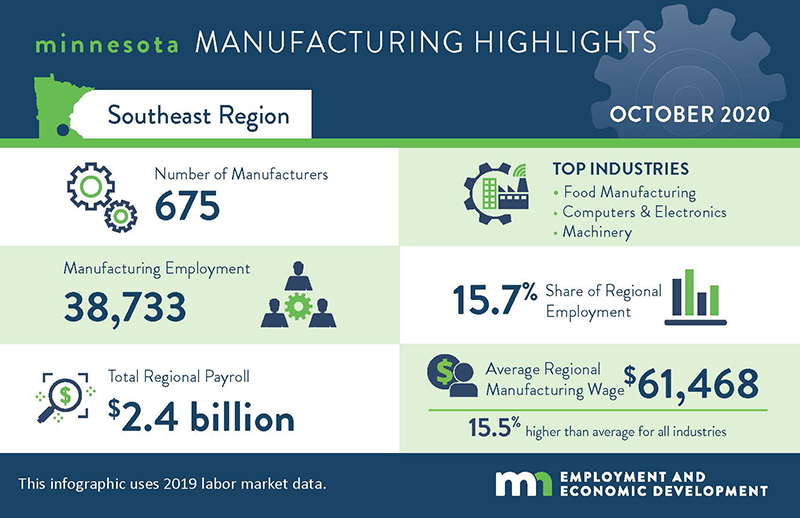 Southeast Minnesota is a health care and agricultural powerhouse. The region is home to the renowned Mayo Clinic and some of the world's most recognized food companies and brands.
Southeast Minnesota is a health care and agricultural powerhouse. The region is home to the renowned Mayo Clinic and some of the world's most recognized food companies and brands.
Advanced manufacturing is especially strong here, with machinery, chemicals, and electronics among the top products.
Want the freshest data delivered by email? Subscribe to our regional newsletters.
10/7/2020 9:00:00 AM
Manufacturing is a significant contributor to the Southeast Minnesota regional economy. In fact, the 11-county Southeast Region was home to 675 manufacturing establishments providing 38,733 jobs on average in 2019, making it the second-largest employing industry in the region (behind Health Care and Social Assistance), according to DEED's Quarterly Census of Employment and Wages (QCEW) data. That equaled 15.7% of the total employment in the region, while also making up 11.9% of the total statewide manufacturing jobs.
Food Manufacturing is the largest sector in Southeast Minnesota, with nearly 10,500 jobs at 108 firms. Over half of these jobs were in Animal Slaughtering & Processing, about 1,800 jobs were in Grain & Oilseed Milling, and nearly 1,300 jobs were in Dairy Product Manufacturing.
Other Manufacturing sectors that set Southeast apart from other regions include a high number of jobs in Computer & Electronic Product Manufacturing, Machinery Manufacturing, and Fabricated Metal Product Manufacturing. Computer & Electronic Product Manufacturing also stands out for its extremely high wages – average annual wages were over $100,000 in 2019 (see Table 1).
| Table 1. Southeast Minnesota Manufacturing Industry Employment Statistics (2019 Annual Averages) | |||||
|---|---|---|---|---|---|
| NAICS Industry Title | Number of Jobs | Percent of Mfg. Jobs | Number of Firms | Total Payroll | Average Annual Wage |
| Total, All Industries | 246,760 | N/A | 12,660 | $13,132,325,886 | $53,196 |
| Manufacturing | 38,733 | 100.0% | 675 | $2,380,846,930 | $61,464 |
| Food Manufacturing | 10,479 | 27.1% | 108 | $589,623,132 | $56,264 |
| Computer & Electronic Product Manufacturing | 4,931 | 12.7% | 27 | $499,360,173 | $101,244 |
| Machinery Manufacturing | 4,489 | 11.6% | 64 | $265,184,804 | $59,072 |
| Fabricated Metal Product Manufacturing | 4,239 | 10.9% | 124 | $224,577,480 | $52,936 |
| Nonmetallic Mineral Product Manufacturing | 2,835 | 7.3% | 50 | $164,332,884 | $57,928 |
| Miscellaneous Manufacturing | 1,657 | 4.3% | 67 | $71,164,948 | $42,952 |
| Furniture & Related Product Manufacturing | 1,489 | 3.8% | 44 | $79,581,125 | $53,404 |
| Plastics & Rubber Products Manufacturing | 1,377 | 3.6% | 22 | $66,439,464 | $48,256 |
| Chemical Manufacturing | 1,335 | 3.4% | 22 | $96,759,882 | $72,488 |
| Printing & Related Support Activities | 1,301 | 3.4% | 42 | $61,366,455 | $47,164 |
| Wood Product Manufacturing | 701 | 1.8% | 27 | $31,133,181 | $44,356 |
| Textile Product Mills | 588 | 1.5% | 13 | $33,534,125 | $56,992 |
| Transportation Equipment Manufacturing | 572 | 1.5% | 14 | $29,973,954 | $52,468 |
| Electrical Equipment, Appliance, & Component Mfg. | 554 | 1.4% | 9 | $34,445,932 | $62,296 |
| Paper Manufacturing | 492 | 1.3% | 7 | $27,329,657 | $55,536 |
| Primary Metal Manufacturing | 468 | 1.2% | 11 | $26,136,804 | $55,796 |
| Beverage & Tobacco Product Manufacturing | 153 | 0.4% | 18 | $2,368,176 | $15,444 |
| Source: DEED Quarterly Census of Employment and Wages | |||||
 The workforce in Southeast Minnesota's Manufacturing industry has seen some shifts along race and origin lines over time, with the entire industry becoming more diverse. In 2004, 94% of manufacturing workers identified as white alone, while in 2019 this percentage had dropped to 86.9%. The largest employment gains occurred for Black or African American workers, which increased by 170% from 2004 to 2019, followed by increases in the number of those identifying as Two or More Races (+140.3%), while the number of Asian workers doubled. In addition, those identifying as Hispanic or Latino also saw their presence increase by 36.5% (see Figure 1).
The workforce in Southeast Minnesota's Manufacturing industry has seen some shifts along race and origin lines over time, with the entire industry becoming more diverse. In 2004, 94% of manufacturing workers identified as white alone, while in 2019 this percentage had dropped to 86.9%. The largest employment gains occurred for Black or African American workers, which increased by 170% from 2004 to 2019, followed by increases in the number of those identifying as Two or More Races (+140.3%), while the number of Asian workers doubled. In addition, those identifying as Hispanic or Latino also saw their presence increase by 36.5% (see Figure 1).
Manufacturing will continue to be a dominant economic force in Southeast Minnesota. However, employers who have altered – or are working to alter – their hiring practices and recruitment approaches to be more inclusive are more likely to find the workers they need. Developing more inclusive hiring practices is a double-win for the region as it will help people obtain and retain employment in higher-paying industries and will help employers fill job vacancies with quality workers.

Contact Mark Schultz.